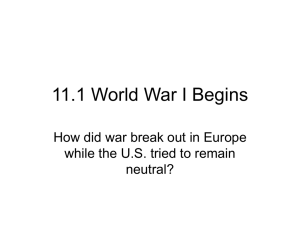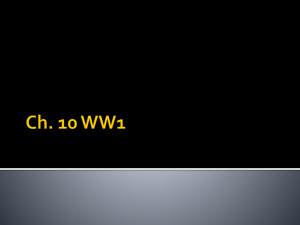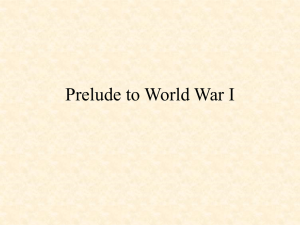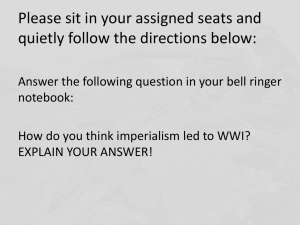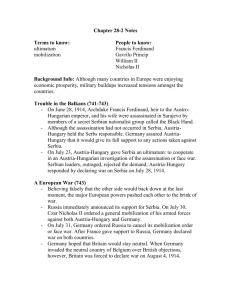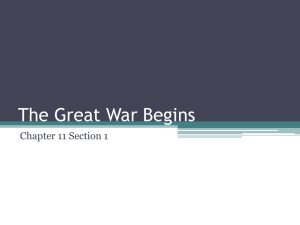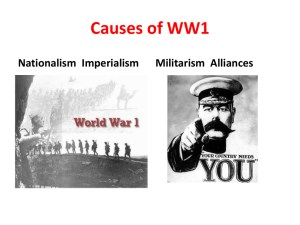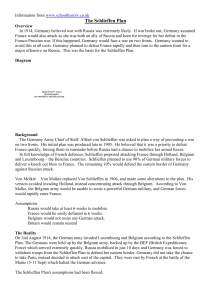Unit 5- Chapter 34 Test.doc
advertisement
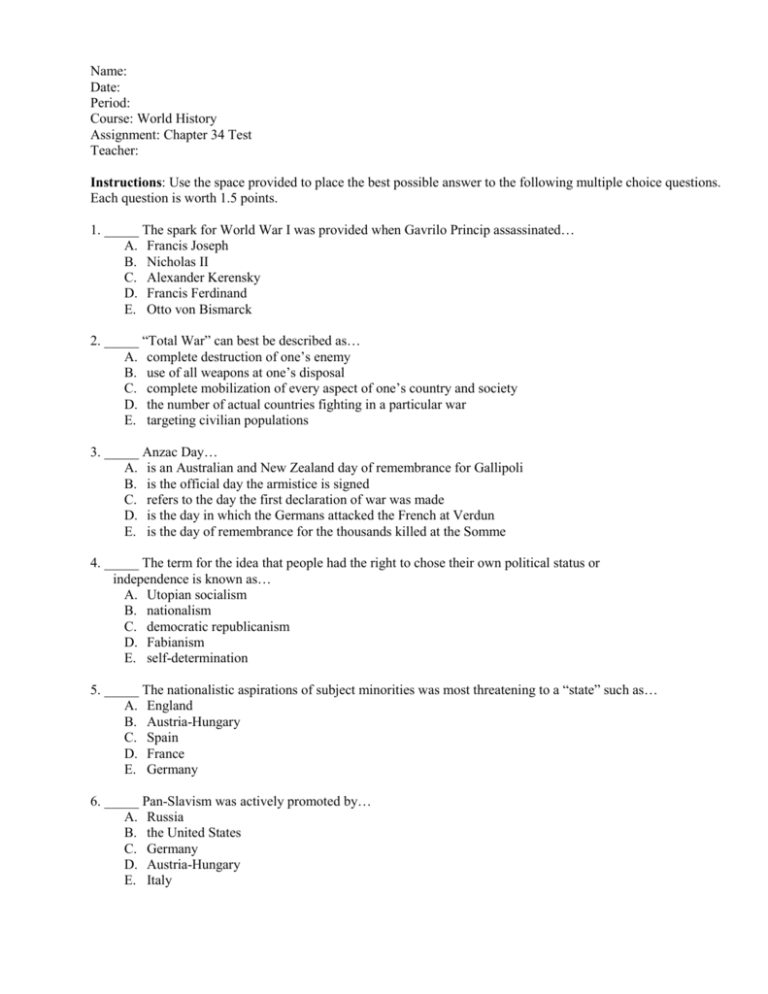
Name: Date: Period: Course: World History Assignment: Chapter 34 Test Teacher: Instructions: Use the space provided to place the best possible answer to the following multiple choice questions. Each question is worth 1.5 points. 1. _____ The spark for World War I was provided when Gavrilo Princip assassinated… A. Francis Joseph B. Nicholas II C. Alexander Kerensky D. Francis Ferdinand E. Otto von Bismarck 2. _____ “Total War” can best be described as… A. complete destruction of one’s enemy B. use of all weapons at one’s disposal C. complete mobilization of every aspect of one’s country and society D. the number of actual countries fighting in a particular war E. targeting civilian populations 3. _____ Anzac Day… A. is an Australian and New Zealand day of remembrance for Gallipoli B. is the official day the armistice is signed C. refers to the day the first declaration of war was made D. is the day in which the Germans attacked the French at Verdun E. is the day of remembrance for the thousands killed at the Somme 4. _____ The term for the idea that people had the right to chose their own political status or independence is known as… A. Utopian socialism B. nationalism C. democratic republicanism D. Fabianism E. self-determination 5. _____ The nationalistic aspirations of subject minorities was most threatening to a “state” such as… A. England B. Austria-Hungary C. Spain D. France E. Germany 6. _____ Pan-Slavism was actively promoted by… A. Russia B. the United States C. Germany D. Austria-Hungary E. Italy 7. _____ All of the following are true regarding the end of World War I except… A. An armistice was signed 11/11/18 to end the fighting B. The “Big Four” and later the “Big Three” were the architects of the Treaty of Versailles C. Woodrow Wilson was able to include 8 of his 14 points into the Treaty of Versailles D. Germany was to admit responsibility for the war E. The United States would never become a member of the League of Nations 8. _____ The strategy of a “war of attrition” attempts to… A. find a diplomatic end to conflict B. deliberately targets civilian populations C. wear down the enemy to a point where they would rather give up than fight on D. increase the number of fighting troops in order to end the war quickly E. all of the above are true 9. _____ The German offensive of 1914 was halted at A. Gallipoli B. the Marne C. Verdun D. the Somme E. Prussia 10. _____ The members of the Triple Alliance were… A. England, France, and Russia B. Germany, Austria-Hungary, and Russia C. Russia, Italy, and Germany D. Germany, Austria-Hungary, and Italy E. England, France, and Italy 11. _____ All of the following are examples of nationalism except… A. the Triple Alliance B. Serbians assassinating Franz Ferdinand C. Pan-Slavism D. Self-Determination E. Italian unification 12. _____ The French were deeply suspicious of German expansion because of… A. Germany’s role in the final defeat of Napoleon B. the solid total alliance between the British and Germans C. the rise of Adolf Hitler D. the French’s inability to forget their humiliating defeat in the Franco-Prussian War E. German support for Basque separatists 13. ______ Which of the following was not a characteristic of the new total war of World War I? A. the use of propaganda to inspire the participants to even greater sacrifice B. unprecedented slaughter caused by new weapons C. the extension of laissez-faire capitalism to its greatest freedom D. the recognition of the importance of the home front in the war effort E. the implementation of the draft in many countries 14. _____ Gavrilo Princip was a member of a secret Serbian society known as the… A. Black Shirts D. Yugoslavs B. Black Hand E. The Young Turks C. Young Serbians 15. _____ The last tsar of Russia was… A. Alexander II B. Ivan IV C. Nicholas II D. Ivan III E. Alexander III 16. _____ Central to the Schlieffen Plan was a lightning invasion through… A. Russia B. England C. Germany D. Belgium E. Switzerland 17. _____ The soldiers who marched off in 1914 to fight in World War I were mostly… A. depressed because they remembered the slaughter of the Franco-Prussian War B. mercenary troops C. draftees D. depressed because of their religious opposition to the war E. wildly enthusiastic 18. _____ “To make the world safe for democracy” was the motto of the… A. Russians B. Americans C. Austrians D. Ottomans E. Italians 19. _____ Which of the following was not a widely used weapon of World War I? A. Chemical weapons B. U-Boats C. Machine guns D. Airplanes E. Thermo-nuclear bombs 20. _____ The western front in World War I was… A. a bloody stalemate B. a German victory after the French abandoned their English allies C. an overwhelming French and English victory D. a relatively easy German victory E. an Italian victory that changed the shape of the war 21. _____ Plan XVII was… A. an American plan based on a surprise attack from the East B. a British plan that relied heavily on naval blockades C. a French plan based on a continuous series of offensive attacks D. a German plan calling for an invasion of France through Belgium E. a French plan that stressed a defensive, trench-oriented response to German maneuvers 22. _____ The Somme was… A. the battle in 1914 that halted the German Schlieffen plan B. a huge German offensive against the French lines in 1916 C. a disastrous Italian defeat that destroyed any hope for an Italian invasion of Austria D. the first great American victory of the war E. an English assault in 1916 that gained a few thousand yards and killed hundreds of thousands of soldiers 23. _____ World War I began when… A. Serbia declared war on Germany B. Serbia declared war on Austria-Hungary C. Germany declared war on France D. Austria-Hungary declared war on Serbia E. Russia declared war on Austria-Hungary 24. _____What effect did World War I have on the status of women? A. Working-class women enjoyed the greatest advancement in economic opportunity. B. Women in many countries received the right to vote in the years after the war C. All women took advantage of new economic opportunities, which lasted long past the end of the war. D. The slaughter caused by capitalistic tensions caused 32 percent of women to join the military E. The demands of total war actually reduced the opportunities for women. 25. _____Which one of the following is not an explanation of the expansion of World War I to Asia, Africa, and the Pacific? A. European nations carried their animosities into their colonies. B. Japan saw the war as an opportunity to grab German colonies. C. The German invasion of neutral Belgium was a violation of international law. D. Europeans were forced to recruit soldiers from their colonies because of the demands of the war. E. Other nations entered the war for reasons that had nothing to do with the murder of Francis Ferdinand. 26. _____ The United States initially stayed out of the war because… A. no Americans were killed B. no U.S. colonies were threatened C. U.S. borders had not been invaded or threatened D. Americans were profiting off of both sides in the beginning of the war E. all of the above are true 27. _____ The Japanese entered World War I because of their… A. anger over German atrocities against Chinese civilians B. long-standing Franco-Japanese alliance C. fear of America entering into China D. desire to acquire German colonies in Asia E. concern over Austrian colonial aspirations in the Pacific 28._____ The Battle of Gallipoli… A. resulted in the final defeat of the Ottoman empire B. finally broke the long-standing stalemate on the western front C. handed German African colonies over to Allied control D. destroyed Russian resistance E. was a failure for Australia and New Zealand 29. _____ The massive German assault on the western front in 1916 that became a morale boost for France was… A. the Somme D. Verdun B. the Marne E. Ypres C. Gallipoli 30. _____The main reason for the failure of the provisional government in Russia in 1917 was… A. its inability to satisfy popular demands for an end to the war B. the growing rivalry between Stalin and Trotsky C. the strain placed on the government by the unpopular alliance with Germany D. the public’s desire for total victory, which clashed with the government’s pacifism E. Lenin’s inexperience in actually running a government 31. _____ The Twenty-One demands were issued A. by the U.S. to Japan B. by Japan to China C. by Austria to Serbia D. by England to Germany E. by Germany to France 32. _____ The experience of Joseph Caillaux during World War I demonstrated that… A. the war expanded the scope of civil liberties because of increased respect for freedom B. many industrialists used the war to make fantastic profits C. anti-Semitism was on the rise D. governments resorted to the restriction of civil liberties E. each nation invested heavily in elaborate spy networks 33. _____ The Treaty of Brest Litovsk… A. was harsh toward the Germans and led to resentment after the war B. forged the alliance between England & France that would later become the Triple Entente C. forced the Chinese to give Hong Kong to the British D. ended Russia’s involvement in World War I E. was shaped by American desires 34. _____ The key factor in the United States’ decision to enter World War I was… A. its long-standing friendship with Great Britain B. its position as leader of the free world C. the U.S. desire to pick up German colonies in the Pacific D. age-old antagonism between the United States and the Ottoman Turks E. Germany’s resumption of unrestricted submarine warfare 35. _____ Woodrow Wilson agreed to many harsh stipulations to the Treaty of Versailles… A. because he felt that Germany had to be punished on a world stage B. because of his personal hatred of the French C. in return for the creation of the League of Nations D. because of his hatred for Germany, caused by the sinking of the Lusitania E. as a means of showing that democracy was the single best form of government 36. _____ The mandate system… A. led to the occupation of Germany after the war B. allowed the Germans to repay their reparations to the Allied powers C. allowed for the rapid spread of communism D. angered the Arab world because it was little more than a glorified form of imperialism E. all of the above are true MATCHING: For questions 37-46, use the space provided to match the term on the left with the best possible clue on the right. A clue may only be used once. Not all clues will be used. 37. ______ Woodrow Wilson A. Italian prime minister after World War I 38. ______ Otto Von Bismarck B. Harsh settlement against Germany 39. ______ Paris Peace Conference C. Formulated a battle plan that ran through Belgium 40. ______ July Ultimatum D. Ended Russia’s involvement in WWI 41. ______ Alfred von Schlieffen E. Meeting to discuss the conditions for a post-war Europe 42. ______ No-Man’s Land F. Reformed Turkey into a secularized republic 43. ______ Dual Alliance G. Strip of land between the trenches 44. ______ Ataturk H. The super battleships of Britain I. Defensive pact between Germany & Austria-Hungary 45. ______ Treaty of Versailles 46. ______ Bolsheviks J. Pushed for the creation of the League of Nations at the Paris Peace Conference K. Series of treaties signed at the end of the war L. Responsible for the unification of Germany M. Demands given to Serbia by Austria-Hungary in response to Ferdinand’s assassination ______________________________________________________________________________ Map: Use the map to answer questions 47-50. Each question is worth 1.5 points. B D C E A 47. _____ Identify the location where the combined force of allies was defeated at Gallipoli A. A B. B C. C D. D E. E 48. _____ Identify the location/country where Germany intended to go through in order to attack the French according to the Von Schlieffen Plan. A. A B. B C. C D. D E. E 49. _____ Identify the letter that represents the three independent countries known as the “Baltic States.” A. A B. B C. C D. D E. E 50. _____ Identify the location that represents the country in which Serbia became a part of after the war. A. A B. B C. C D. D E. E ANSWERS: 1. D 2. C 3. A 4. E 5. B 6. A 7. C 8. C 9. B 10. D 11. A 12. D 13. C 14. B 15. C 16. D 17. E 18. B 19. E 20. A 21. C 22. E 23. D 24. B 25. C 26. E 27. D 28. E 29. D 30. A 31. B 32. D 33. D 34. E 35. C 36. D 37. J 38. L 39. E 40. M 41. C 42. G 43. I 44. F 45. B 46. D 47. A 48. C 49. B 50. E
